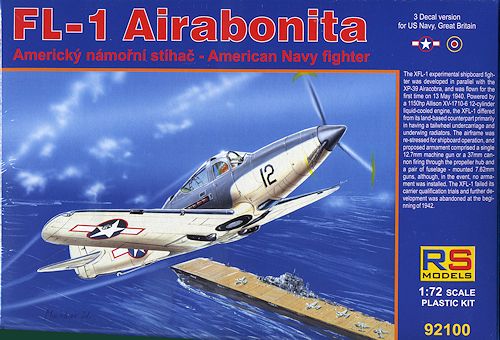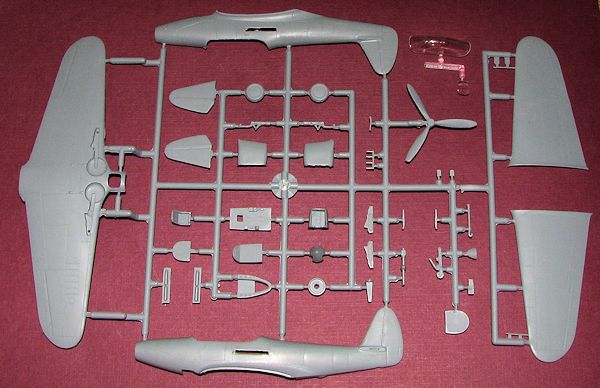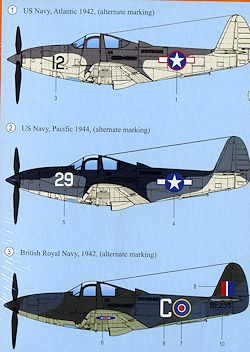
RS Models 1/72 XFL-1 Airabonita
| KIT #: | 92100 |
| PRICE: | $17.80 on sale ($29.95 SRP) |
| DECALS: | Three options |
| REVIEWER: | Scott Van Aken |
| NOTES: | Short run kit |

| HISTORY |
The XFL-1 (Bell Model 5) was powered by a single Allison XV-1710-6 piston engine installed amidships behind the pilot and driving a three bladed Curtiss propeller in the nose through a 10.38 ft (3.16 m) extension shaft. The aircraft had provisions for a single 37 mm (1.46 in) Oldsmobile T9 cannon which could be replaced by a .50 in (12.7 mm) Browning M2/AN machine gun through the propeller shaft and two .30 in (7.62 mm) machine guns in the fuselage nose. It first flew on 13 May 1940.
Although based on the P-39, the XFL-1 utilised a conventional tail-wheel undercarriage and the coolant radiators were housed externally in fairings under the wings instead of within the wing center section. The Allison engine was the first of its type to be tried out by the Navy and lacked the turbosupercharger fitted to the XP-39.
Delivery of the prototype to the U.S. Navy was delayed due to difficulties with the Allison engine until February 1941 and it was not accepted as navy property until March. During tests, the aircraft was plagued with engine and landing gear problems and was returned to Bell for modifications in December 1941, but before the modifications were completed, the U.S. Navy decided that the XFL-1 was not suitable for further development.
As a possible further reason for the rejection it is often stated that the Navy's position during that era was that all its aircraft should use air-cooled engines (while the Allison was liquid-cooled). This appears unfounded speculation. The U.S. Navy "would consider a liquid-cooled engine installation provided a material increase in performance over air-cooled engine can be shown."[3]
In addition, the Allison engine had only a single-speed supercharger, consequently, its altitude performance was much inferior to other naval fighters of the period such as the Grumman F4F Wildcat.
Lastly, the Airabonita had to compete against the considerably faster Vought F4U Corsair, the first U.S. Navy fighter to exceed 400 mph (644 km/h) in level flight.
The XFL-1 was later used for non-flying armament tests, and later destroyed. For many years its remains were visible at the dump at U.S. Naval Air Station Patuxent River, Maryland.
| THE KIT |
 Molded in a
grey plastic, the single color sprue has been cut into sections so it will fit
into the smaller box. A one piece canopy and the lower view window comprise the
clear sprue. This kit has no photo etch or resin. Molding is really very good
with crisply done engraved panel lines. The large parts have some ejector towers
that will need to be removed and even some smaller bits such as the seat, floor,
and interior bulkheads have these items. There is no cockpit sidewall detail.
There is a very small amount of flash on a few parts.
Molded in a
grey plastic, the single color sprue has been cut into sections so it will fit
into the smaller box. A one piece canopy and the lower view window comprise the
clear sprue. This kit has no photo etch or resin. Molding is really very good
with crisply done engraved panel lines. The large parts have some ejector towers
that will need to be removed and even some smaller bits such as the seat, floor,
and interior bulkheads have these items. There is no cockpit sidewall detail.
There is a very small amount of flash on a few parts.  er
sections. Engine exhaust stacks are apparently designed to be installed from the
inside of the fuselage halves so this is something that should not be overlooked
in the build.
er
sections. Engine exhaust stacks are apparently designed to be installed from the
inside of the fuselage halves so this is something that should not be overlooked
in the build.  three
whiffer schemes. One is the box art scheme for USN in the 'Atlantic' scheme.
Another is in the tri-color scheme, and the third is a British FAA scheme. Those
wishing to do the prototype will find it pretty easy to do. The prototype was in
overall silver lacquer with yellow wings and the usual pre-war insignia with a
red, white, and blue striped rudder. No other distinguishing markings. The decal
sheet that is provided is very nicely printed and is quite thin.
three
whiffer schemes. One is the box art scheme for USN in the 'Atlantic' scheme.
Another is in the tri-color scheme, and the third is a British FAA scheme. Those
wishing to do the prototype will find it pretty easy to do. The prototype was in
overall silver lacquer with yellow wings and the usual pre-war insignia with a
red, white, and blue striped rudder. No other distinguishing markings. The decal
sheet that is provided is very nicely printed and is quite thin. | CONCLUSIONS |
I am not a huge fan of whiffer paint jobs, but when I find kits like this on sale, I grab them, knowing that it is easy to do the aircraft as it really existed. This looks like a pretty straight-forward build and thanks to the lack of exotic materials, should be a very good kit for those just getting into doing short run kits.
| REFERENCES |
http://en.wikipedia.org/wiki/Bell_XFL_Airabonita
April 2013
Thanks to me for picking this one up.
If you would like your product reviewed fairly and fairly quickly, please contact the editor or see other details in the Note to Contributors.